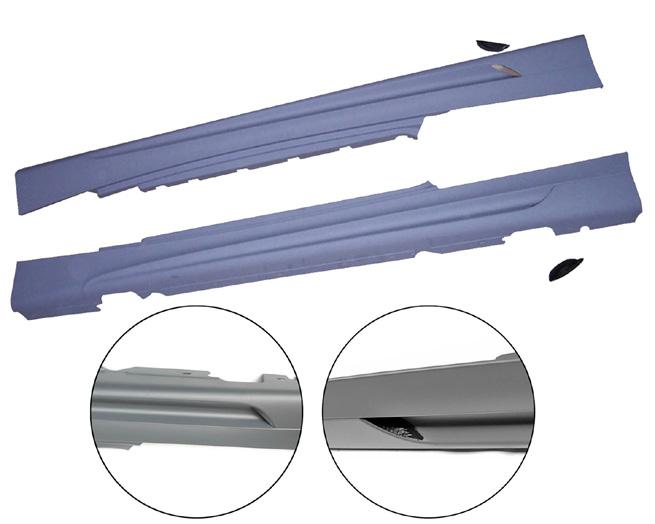
63 minute read
Products
M-Style Side Skirts for BMW E82/88 Models
BMW no longer offers genuine BMW side skirts for the E82/E88 1 Series models; however, M-Style is pleased to announce that it now has its own version available.
Advertisement
The PU-RIM mouldings come complete with air scoops and grille mesh and are available at £195 per pair including VAT.
The side skirts will fit 2013 model-year convertible and coupe models (except 1M coupe) with Mtech / M sport rear bumper.
M-Style can also offer a fitting and painting service at extra cost.
Prep and painting only: £160 extra (buyer will need to collect finished sills)
Painting and fitting: £200
For further details e-mail info@mstyle.co.uk or call 0208 598 9115
M-Style Ghost Immobiliser
The long winter nights are ideal for car thieves. Whilst there are lots of antitheft devices on the market today, M-Style recommends and fits the Ghost Immobiliser for several very good reasons: • The Ghost immobiliser has no key-fobs or LED indications to give away its location. • The Ghost uses the buttons that are already in your vehicle (such as those on the steering wheel, door panels or centre console) to allow you to make a unique, changeable PIN code sequence that must be entered before the car can be driven.
• There are no physical locks for a thief to pick. • There is no remote control for a thief to scan.
• If a thief takes your car while the engine is running, as soon as it is stopped it won’t restart.
M-Style can supply and fit a Ghost Immobiliser system for just £449.00 including VAT.
Essex based Atspeed Racing have been one of the leading tuners of performance ECUs for quite a time. Now the company has turned its attention to remapping standard production cars including many BMW and Mini models.
Visit http://www.atspeedracing.co.uk/remapping-essex and use the calculator to see what is available for your car.
As an example an Atspeed remap would take an E90 320d from 163bhp to 215bhp and the increase the torque from 350Nm to 420Nm.
In addition to a basic remap for improved power, torque and economy Atspeed can provide various additional tuning for certain models to fine-tune the ECU operation of other functions such as the anti-lag, Adblue, Vmax and the start/stop systems.
Use the online appointment form or call 01268 773377 to arrange a Covid compliant drop off.
For more details contact Atspeed Racing on 01268 773377 or visit their website: www.atspeedracing.co.uk
M-Style can also supply and fit Thatcham Cat. 5/6 tracking systems.
For further details e-mail info@mstyle.co.uk
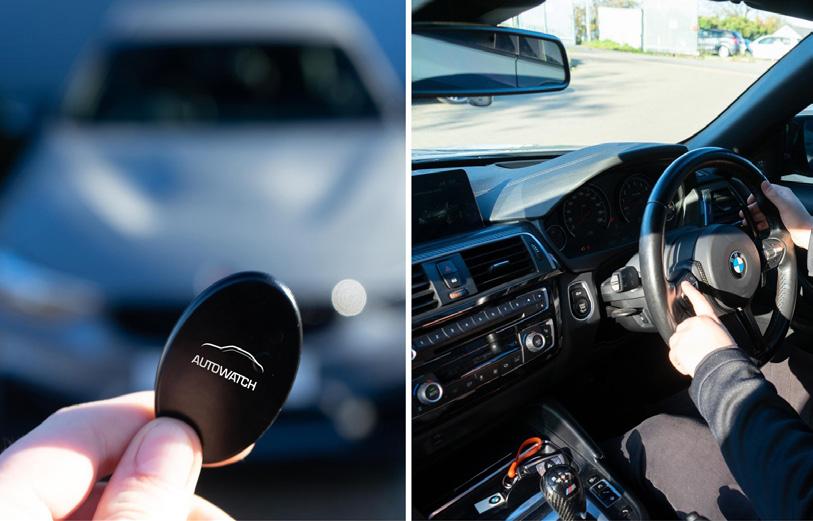
Atspeed now provide remapping for standard cars
or call 0208 598 9115

Cobra Sport’s BMW M4 (F82) Coupé 3” Primary De-Cat Downpipe Performance Exhaust
Cobra Sport catless turbo downpipes produce a deeper exhaust note and allow the turbos to spool quicker for sharper throttle response and power delivery. Matched with a remap, this part allows for significant power improvements.
This BMW M4 performance exhaust is made in 3”/76.2mm bore pipework and replaces the primary catalysts (Cat Bypass).
NB: This de-cat sports exhaust is sold for motorsport and off road use only and will NOT be able to pass a UK MOT emissions test or police roadside checks.
EML lights may activate after removing the standard primary O/E catalyst. An ECU remap is recommended to correct this problem and stabilise all power increases.
Requires 2 x BMW gasket - part number 18307851168 - all other relevant gaskets and fittings are supplied Cobra Sport exhausts systems come with a lifetime warranty for the original purchaser, giving you ultimate peace of mind. All Cobra Sport exhausts are manufactured in the UK from certified grade 304 stainless steel and TIG welded for a superior quality finish. Fits to standard M4 exhaust (Pre-PPF models only) and the Cobra Sport primary cat back exhaust (BM104TP84). Does not fit M4 Competition model.
£600.00 Incl. VAT
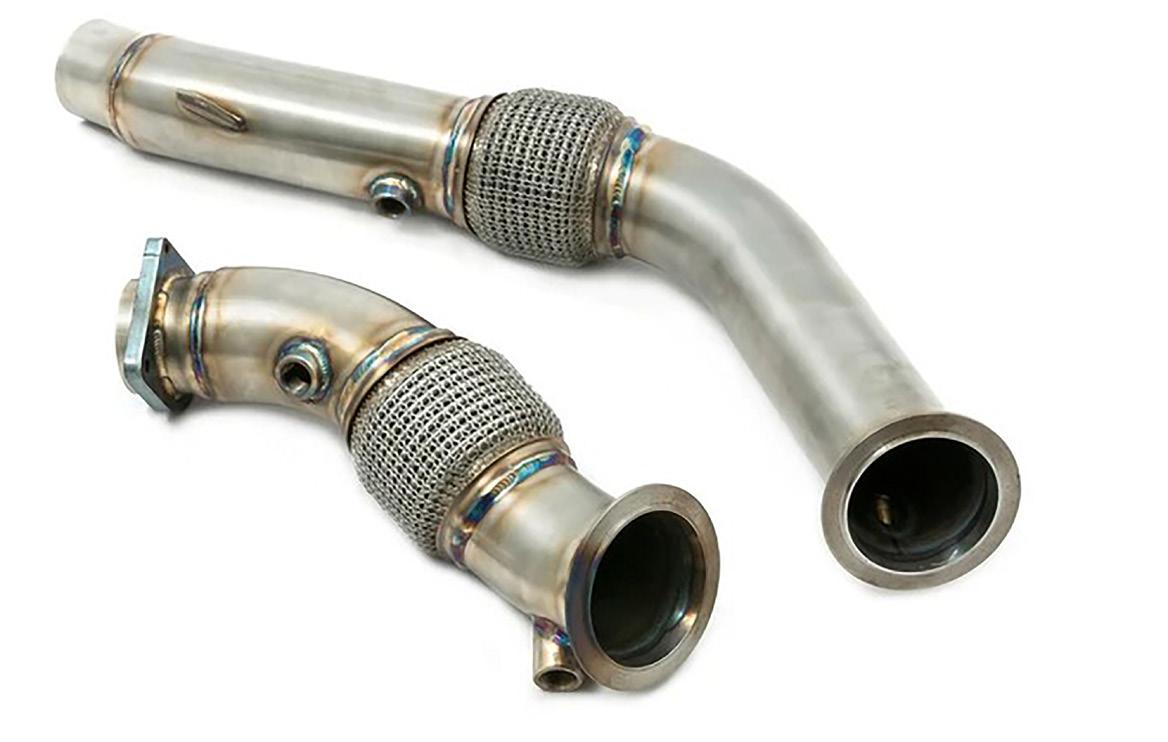
Visit: https://cobrasport.com for further details.
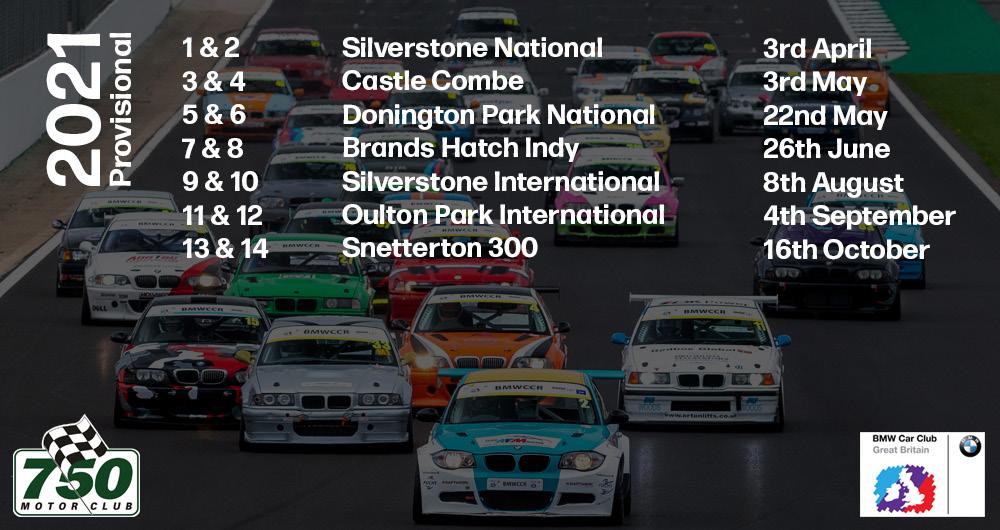
LIFE Analogue to Digital…
Words - Jeff Heywood Photography– BMW Classic & Jeff Heywood
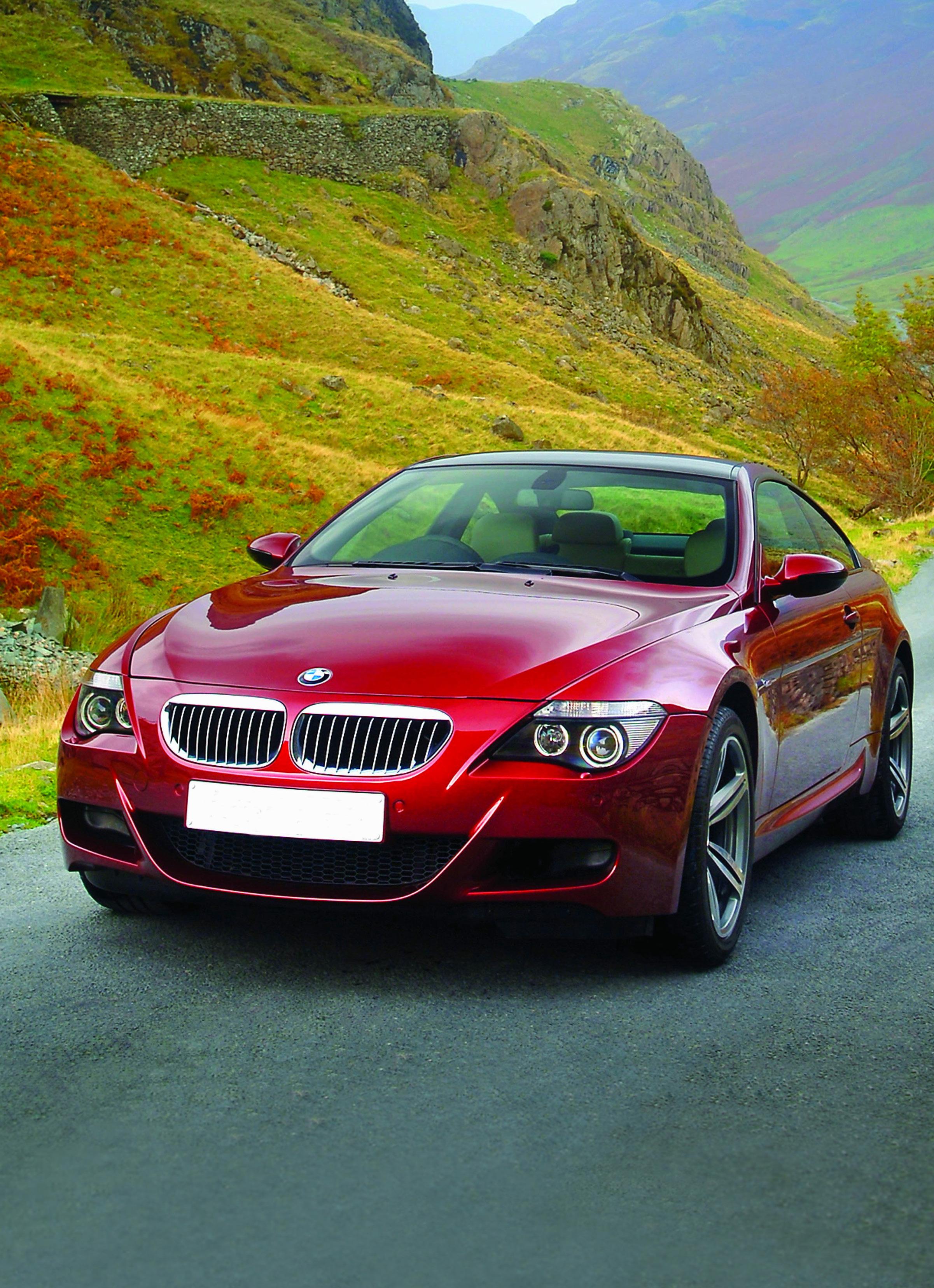
Hot on the heels of the E60 M5’s release in the spring of 2005 came the E63 M6, launched exactly six months later. BMW were riding high on the favourable reviews of the new M5 and its barnstorming S85B50 V10 engine, but just how good is the E63 M6, the first 6 Series M car for sixteen years?
The E63 6 Series was introduced in 2003, but it would take a further two years before the M Powered version finally appeared. Its 500bhp motorsport-inspired V10 was a true innovation for BMW at the time, even if it shared very little in common with their Formula One engine, apart from its configuration and being cast in the same foundry. Gas-guzzling, naturally aspirated and thoroughly intoxicating, it’s an old-school brute and a rarity in today’s modern world of downsizing and turbocharging. When fitted to the 6 Series it created a monster – the BMW M6. But first, the M5.
In 2004 the E60 generation M5 was ahead of its time, and was the first saloon car to come equipped with a V10 engine. Boasting a launch control system that helped propel the 1,755kg limousine from 0-60mph in a then staggering 4.5 seconds, it ran onto a top speed of 205mph – once the electronic limiter was removed. The M5 was a hit, even if the reviews of Bangle’s design were mixed, with quotes of ‘Dame Edna Everage’ glasses commonplace when describing the M5’s headlights and front end styling.
Less than a year later the E63 M6 went on sale, quickly followed by the E64 M6 Convertible. This newest generation saw the M6 utilise the M5’s world-class drivetrain and SMG paddleshift transmission. BMW then fitted this package into the E63’s coupe body shell, which was now lower and lighter than the M5 and also visually far sleeker. This reduced the 0-60 time to 4.2 seconds, meaningfully 0.3 seconds quicker than the M5 could manage, and although the top speed remained the same at a limited 155mph, with the limiter removed the more slippery M6 could hit 210mph flat out. Back in 2005, it was BMW’s fastest production car to date.
If you were lucky enough to be in a position to purchase an M6, you would have been pleasantly treated to a long list of standard equipment, meaning there was no need for thousands to be spent on extra options, although BMW naturally provided them anyway. A seven-speed sequential gearbox, M-differential, plus three-mode damping and adjustable stability and traction control systems were all standard fitment. It didn’t stop there, as a state-of-the-art head-up display featured in the car along with some tasteful 19-inch deep-dish alloy wheels encasing the vast ventilated discs. All of this brought the new M6 to a £79,760


The E63 M6 has matured well, and still looks fresh and modern today, and certainly turned a few heads on my run.
list price, and as the final cars began to depart showrooms in early 2011 the price had risen to £87,335. Today, you can pick up a leggy, uncared for example for under £15,000…if you’re brave.
Despite the enticing second-hand list price, these cars are not cheap to run. Rear tyres and brakes need to be replaced frequently, and those can turn out to be rather expensive, coupled with fuel consumption in the mid-teens at best. In addition to the usual costs, if anything goes pear shaped the repair costs can be sky high so a trusted warranty scheme is advised. Buying a low mileage, mint example is the safest way to enjoy M6 motoring.
We could dedicate two whole issues of Straight Six to the S85B50 engine’s spec alone, but these are the highlights: Bi-Vanos variable valve timing (which allows both exhaust and inlet valves to vary their opening times), an ECU, the most powerful automotive computer at the time, managing 10 individual computer-controlled throttle bodies, and a full stainless steel exhaust system. It’s a powertrain engineer’s dream and one of the finest road car engines ever built. The V10 is linked to an SMG gearbox, as no manual was available in the UK and Europe. It has seven gears and more functions than you’d believe possible, but the basic options are an auto without the benefit of a torque converter, or a manual with paddles behind the steering wheel and a rather grabbable lever in the usual position, which allows you to play touring car driver.
Before we get any further, let’s take a look at the maladies that can afflict the M6 and that glorious motor. The iconic V10 is a bittersweet product that offers outstanding performance and harmonises a sound of pure aural beauty, but in its later years it has developed some major problems. Even cars with just 70,000 or 80,000 miles on the clock (remember the earliest versions are now 15-years old, so that’s only around 5,000 miles per year) will most likely end up with dropped valves or a valve spring failure which results in the need for a rebuilt cylinder bank, which is going to cost a minimum of £2,000, if you are lucky and know a friendly BMW technician. Another known issue is with the spark plugs. If they haven’t been changed for a few years (yes, it does happen) then some of the coils can break and destroy themselves when you start to dismantle them, and they can be a pain to replace on this

The E63 M6 may first and foremost be a grand tourer, but it will also tackle this twisty ribbon of tarmac with aplomb

engine. Throttle bodies are also delicate, so be warned.
In addition to the above, the V10 engine infamously suffers from bottomend failures, and not just on higher mileage examples - some have been known to fail at under 40,000 miles, although to be fair it is the higher mileage and poorly serviced vehicles that suffer the most. The failure of the connecting rod bearings can cause serious damage, which will result in a full engine rebuild - ouch.
Connecting rod bearings wear, mainly because clearances are too tight between the bearings and crank journals, which results in reduced oil flow. This causes excessive bearing surface heat, which leads to metal shavings forming, causing damage throughout the engine (such as the high pressure oil pump and the VANOS actuators). For peace of mind, OEM rod bearings should be replaced every 60,000 miles at a minimum.
The cure for most of the S85B50 engine’s maladies is in regular oil changes using the finest oil available. Most current S85 owners replace the oil in their cars every 5,000 miles or less, and with plenty of these cars having now passed into the hands of enthusiasts who only use them on weekends, it helps to keep the mileage low meaning the oil change regime isn’t as onerous as it sounds. It is also worth using an engine flushing agent when first purchasing an M5/M6 running the S85 to rid the engine of any sludge or deposits that may have built up. Another recommendation is to have a sample of the old oil analysed after every oil change. This isn’t as expensive as it sounds, costing £40-60 per test and is worth building into the car’s maintenance budget. It is a failsafe, picking up microscopic trace elements of metals in the oil sample (like copper), which are ‘shed’ if the bearings are starting to wear prematurely. Having your oil analysed is the best early warning system you can employ when running an S85, allowing you time to organise the replacement of the shells.
With the E63 M6 being the first 6 Series M car in sixteen years, the M division in Garching tried hard. Their biggest challenge was to reduce the new car’s weight without compromising on safety or equipment, while crucially improving on every aspect of the driving dynamics and making it feel like a sports coupé should. It becomes clear that they quickly ran out of the obvious weightsaving options. The usual method of binning sound-deadening materials, the odd airbag, rear seats, centre consoles and every electric seat motor in sight was not acceptable – the M6 was to be a grand tourer, not a stripped out track beast. They went to extraordinary lengths to gain what is officially only a 50kg advantage over the M5.
There are two ways to go about making a car handle. The purest is to strip away the kilos to improve your power to weight ratio and make your chassis more responsive. The second is rarely mentioned outside of motorsport, but was fundamental to the M6’s design brief. If BMW’s M engineers were unable to drastically reduce the mass, then they needed to redistribute some of what remained. Centre of gravity is the Holy Grail of chassis engineering, and the M6’s
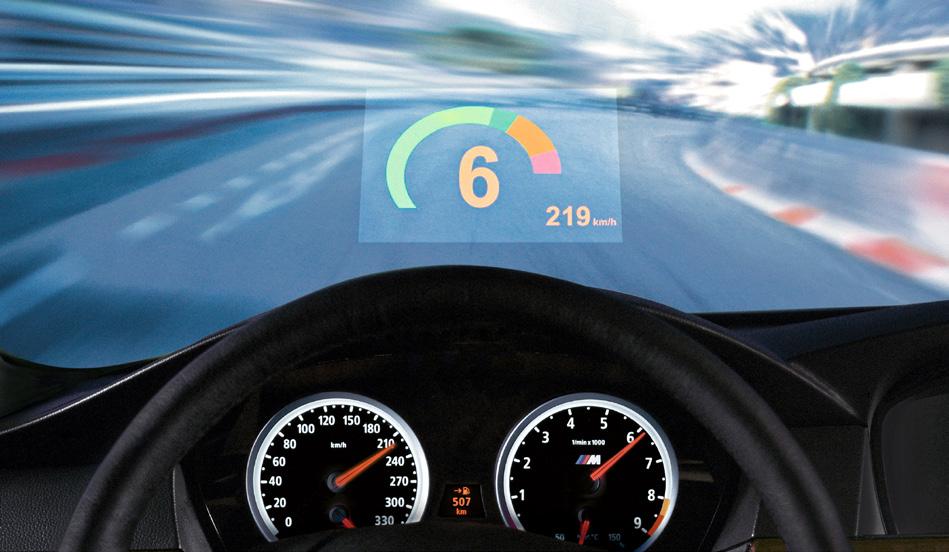

made of carbon fibre, saving 20 and 40 per cent respectively over conventional aluminium items and the rear windscreen is thinner than that of a standard E63.
But however much BMW M wanted us to think that its dietary plan had played the biggest role in shaping the M6, it was actually the tyres (admittedly working in conjunction with the reduced mass and lower centre of gravity) that were the strongest indication of how serious a performance tool the M6 could be. The Pirelli P-Zero Corsa had only been used on two production cars before this: the Ferrari 360 Challenge Stradale and the Porsche 996 GT3 RS. It is a soft compound ‘Cup’ tyre offering much more performance than a regular road tyre, and the results are staggering. If I was asked to define the main difference between
Macclesfield and then back to Stockport, returning on the M60. A route of some 90 miles should be plenty... As I approach the car its Indianapolis Red metallic paintwork is glistening in the weak rays of autumnal sunlight. It’s a good colour for the M6, perfectly suiting the car’s sporty profile. I settle into the M6’s comfortable M sports seats in the leather-lined cabin, after being handed the keys by a good friend who let me borrow this low mileage beauty for this test. The BMW Individual Platinum Merino leather contrasts nicely with the Indianapolis Red exterior paint, providing wonderful and luxurious surroundings in which to drive. The instruments are fully legible and the ergonomics sound. This car might be The M6’s controls all fall ergonomically to hand and instrumentation is clear and legible. feels fresh and modern, partly testament to the low 20,000 miles showing. The is 60mm lower than an M5’s – quite a lot in a road car. Most obvious of these alterations is the fitment of a carbon fibre roof. First seen on the limited-run M3 CSL, this was the first time a carbon roof was used on a full production car, and would go on to be a tell-tale M feature, just like a set of quad tailpipes. The net saving of 4.5kg over a steel roof panel may not seem that special, but the fact that the weight was shaved from the very top of the car is more significant than the overall saving. The roof is bonded in place, and all the work was carried out on the main production line. Next on the weightwatcher’s list are the (rather nice) OEM alloy wheels, the spokes of which barely look strong enough to prop up a supermini, let alone a 1710kg M car! Made of forged aluminium, they shave a full 1.8kg of unsprung mass from another critical area. After this, the attention to weight-carving detail is reduced to infinitesimal levels. The front and rear bumper supports are sharpness. Everything the M5 does, the M6 executes a touch quicker, with more agility and with the benefit of reduced inertia and heightened responses. When compared on paper, the differences aren’t that marked. I can’t, for example, tell you that the steering of the M6 feels any different to that of the M5 - they’re both excellent for accuracy with (unfortunately) not a huge amount of feel. Nor would it be correct to say the M6 rolls less than the M5, but I can tell you that it does scoot through curves quicker and feels more planted. It’s that seat of the pants feeling, and this is where the M6 feels more alive and driveable than the M5, and that’s no slight on the M5. Driving Impressions So what is the M6 like to drive? Fun with a capital F! My route would be a real test; starting in my home area of Saddleworth, heading out of Greenfield village and onto Holmfirth, Stocksbridge, Buxton, head-up display is a welcome addition to the M6 and is something I’m accustomed to after driving BMWs with this feature for over years now, as is the iDrive, which everyone moaned about at the time but actually works just fine, even if it is a touch clunky when compared to the latest systems. I set the M seat (with memory function) to a position that I find comfortable, buckle up, press the start button and set off in P400 mode. 400 horses is more than enough for my short motorway journey, P500 Sport comes later… Having experienced the E60 M5 on a couple of occasions, the M6 is a similar straight-line weapon like little else. Shorn of a few kilos and with an identical 500bhp at 7750rpm and 384lb ft of torque, it’s a car that feels immensely fast, and as I accelerate down the slip road onto the M60 the car feels sublimely effortless, easing onto the motorway, and with the revs barely touching 3000rpm in fourth gear I’m quickly cruising at
pushing 15-years now but the interior still the M5 and M6 in one word, it would be The M6 is a joy to drive at speed, and has true supercar performance, with a 200+mph top speed.
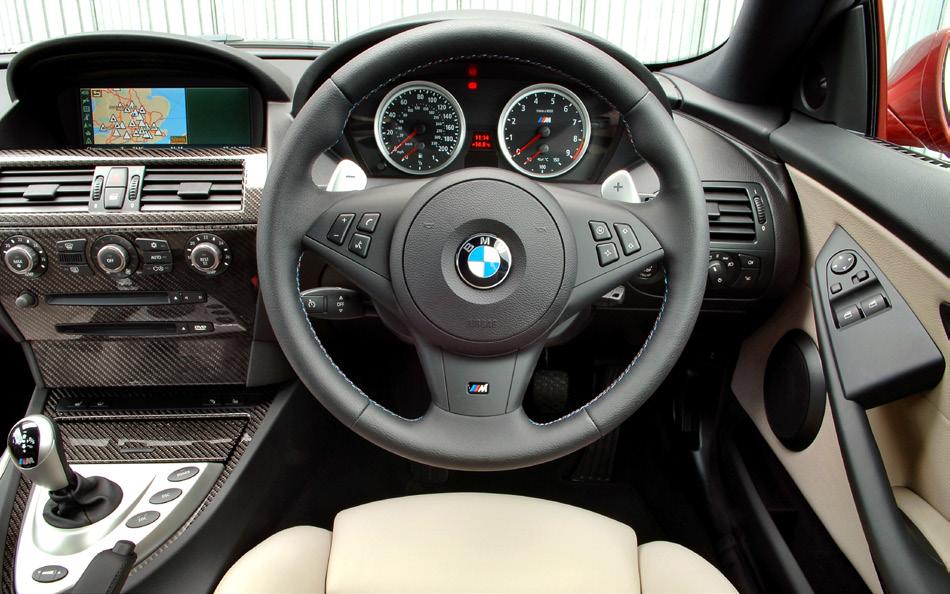
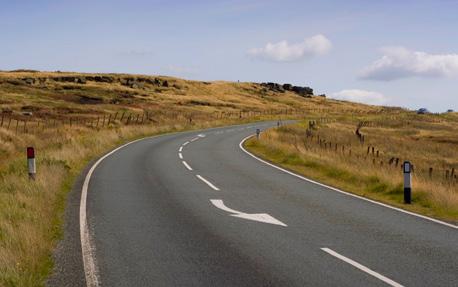

what seems like the never ending climb onto the top of Saddleworth Moor. The road finally flattens out to some degree, undulating and snaking across the moor, a sinuous piece of tarmac designed to keep you out of the putrid peatbog and perfect for cars like the M6. I mash my foot on the throttle and the M6 shoots forward like an Exocet missile, the V10 at 5000rpm and grows into a banshee like howl as we head closer to the red line in each gear. Boy, does the M6 still feel quick! The undulating, heavily cambered A635 will test any car, and the M6 is given a thorough workout on the dips, crests and undulations, that manic V10 howling away as this wicked stretch of road tries it’s best to throw you off into the boggy moorland.
The fun comes to a temporary halt as we head down off the moor and into Holmfirth, home of Nora Batty and Last of the Summer Wine; it is a nice little village and worth a morning or afternoon visit. I follow the B6106 as I depart, happy to be back in P400 mode as this B-road is narrow at times with plenty of parked cars and blind bends as it winds its way uphill.
speed braking runs when I notice the brakes becoming a tad mushy. M cars of this era struggle with brakes if you are repeatedly braking from high speed; a set of Brembo’s finest wouldn’t go amiss. We skirt through the outer suburbs of Sheffield and head to Lidgate, finally escaping the drudgery of suburban stop start driving and a proliferation of mini roundabouts. I must also give the head-up display a mention for providing me with all the info I need – directions from the sat-nav and speed limits, all reproduced on the windscreen in my line of sight yet totally unobtrusive. A wonderful safety item. We pass by Lidgate village and hit wonderful Peak District scenery again as The heart of the beast! BMW’s S85B50 V10 engine is an amazing piece of A621 Baslow Road. Once you escape engineering, producing 500bhp, enough to propel the M6 to 210mph! the last of the Sheffield suburbs the 90mph in hushed silence. The M6’s interior is a wonderfully cosseted place to be, and sitting on a motorway one can immediately gauge what a fine grand tourer this car is. Thankfully the weather is dry when I set out, with the sun trying to break through the clouds in places. I leave the M60 at Ashton-Under-Lyne, keeping the power button in P400 mode it reaches a roundabout where it meets the A628 Woodhead Pass road – another challenging route but not today as we drive straight across the roundabout and continue on the A616 in the direction of Stocksbridge. This section of the A616 is a really fast open trunk road where the M6, now back in P500 Sport mode, eats up the highway as I gun the V10 through roads in the Peak District are sublime for stretching the legs of any car, and this short run on the A621 to Baslow is no exception, the V10 is given its head in the lower gears as it punches its way rather violently down the A621 before we reach a roundabout at Baslow. We then head to the village of Pilsley and take a right onto the A6020 for a short run before we reach the A6, where we take another right in the as I make my way through the urban the gears via the steering wheel mounted direction of Buxton. crawl, heading for the Saddleworth hills. paddles. One has to be careful though, Buxton, as many of you will know, Thankfully we soon clear urbansville and as just as you get nearly half way, there is a beautiful Spa town with the highest reach Greenfield village. As I leave the village via the A635 Isle of Skye road I quickly select P500 Sport as we ascend is a speed camera mounted to catch the unwary. It’s here after a number of high elevation – about 1,000ft above sea level – of any market town in England, engine finally comes alive as it’s wail starts The infamous A635 Isle of Skye road is hugely challenging.
we head south for a short blast on the We join the A616 for about a mile before The E63’s ‘Bangle bustle’ boot was criticised when new but now hardly gets a mention.
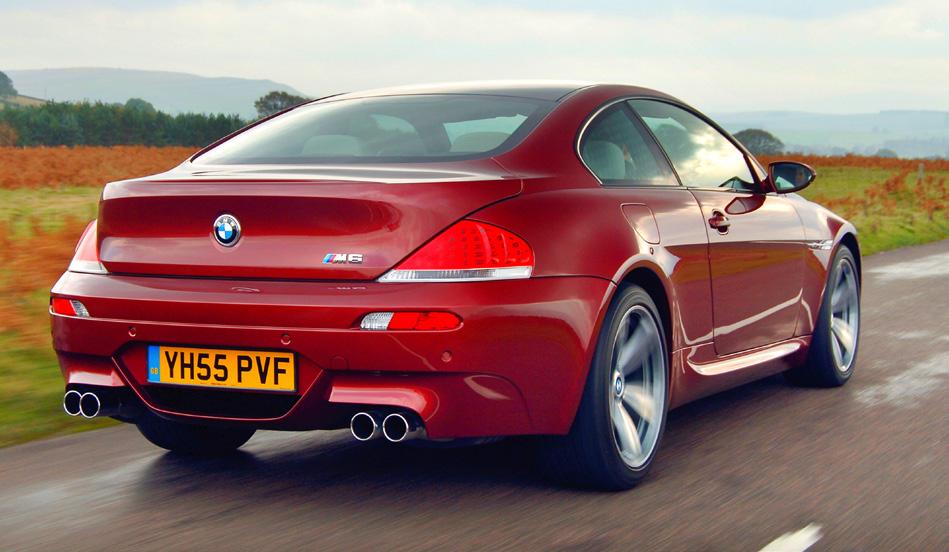
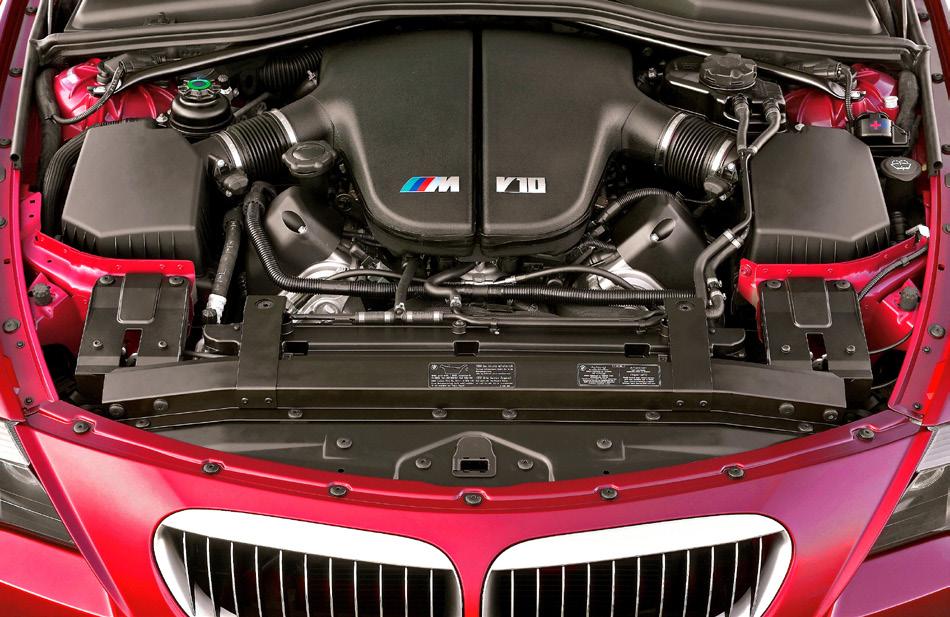

The BMW Individual Platinum leather-clad interior is a classy, welcoming and comfortable place to spend a good few hours behind the wheel.
and is often referred to as the gateway to the Peak District National Park. It is also usually very busy, and today is no exception as we tackle mini-roundabout after mini-roundabout! Thankfully we reach the western edge of the town, passing Poole’s Cavern before we flick right onto the A537, which is one of, if not the finest, driving roads in England, and otherwise known as the Cat and Fiddle Road. A biker’s haven, one only has to look on a map to appreciate this road, with lots of bends and hairpins connected by some amazing straights where you can really stretch the legs of the most potent of machines. Seen in person, taking in its rises, crests and dips as it sinews across some amazing moorland scenery, it resembles in places sections of the Nurburgring – high praise indeed.
The M6 may be a big car, but on roads like this it shrinks around you. Yes, I know that is an overused expression, but it is perfectly applicable in this case. All of the car’s buttons are set to maximum including the P500 Sport setting as we head onto the first section, which is made up of a number of straights linked together by mostly slight to medium bends. When traffic flow allows, I can use all of the road when cornering, straightening out bend after bend as the car sears from gears three to four, with the odd snatch of fifth on the rare occasion. The S85 V10 is intoxicating as it changes its tone from an everincreasing wail as we hit 6000rpm, to a banshee-like scream as the rev counter nudges 8000rpm in each gear, the viciousness of the acceleration pinning me back in my seat as the car quickly hits some seemingly high (alleged) velocities. What is impressive is how the M6 sticks like a limpet in the semi-straightened bends, the sticky Pirelli P-Zero Corsas providing oodles of grip and impressive feedback.
What I am impressed with is the feedback felt through both the steering wheel and the seat of the pants. Obviously it’s no M3 CSL, but the combination of the Pirellis and the M suspension produces (surprisingly) oodles of front end grip and feel, which isn’t completely numbed by the power steering, and the rear suspension really lets you feel what the big E63’s rearend is doing in the twisty stuff. Body roll is present but not alarmingly so and the mass is kept well under control when pressing on. I’m really taking a shine to this car…
The Cat and Fiddle Road has sadly become infamous due to the high number of deaths, with over 70 per cent of those fatalities being bikers. The road is a challenging ‘nirvana’ to motorcyclists; unfortunately due to the fatalities, we find the road patrolled by unmarked police cars and motorcycles, so be warned. There is also a section controlled by average speed cameras which the bikers bypass by heading down Ankers Lane, rejoining the road further along – you couldn’t make it up!
I couldn’t be bothered bypassing the cameras, so I continued along the A537, passing the famous Cat and Fiddle Inn, now a whisky distillery. Just over a mile down the road and we’ve cleared the average speed section - I must admit the 50mph controlled section does remove some of the finest sections of the road from play, which is a great shame.
All too quickly the first signs of housing and the suburbs of Macclesfield appear, and my road trip is nearly complete. I still have about 15 miles to go until I reach the M60 at Stockport, which is conducted on the kinds of wide, sweeping A-roads that the M6 excels on. I work my way through Macclesfield and head out on the A523 in the direction of Poynton and Hazel Grove.
A couple of points worth mentioning as I navigated my way through Macclesfield – I still can’t get on with the SMG’s paddles, and I much prefer to use the gear lever like a racing sequential when gunning the car. Secondly, the M6, resplendent in its Indianapolis Red warpaint, elicits a few second looks as we head through town. I also noticed the same looks as I wound my way through a couple of Saddleworth villages at the start of my trip. It’s nice to know that even after 15 years the M6 is still a bit of a head turner – and all you doubters said Bangle got it wrong!
On major A-roads the M6 wafts along and cocoons its passengers, the leatherlined and air conditioned cabin cosseting as it slips into the roll of consummate grand tourer. As we reach Stockport I
hit the start of the rush hour traffic and it does give me time to contemplate the M6 as I crawl towards the motorway junction. I condense my thoughts, thinking about what I’m going to write; the consumption of Shell’s finest at 14mpg for my test run is quite sobering, although the car is excused because I was either peddling the M6 along at a fair old lick or sat in the suburban crawl, neither of which is ideal for a large, heavy V10 coupe, so I’ll forgive the car it’s prodigious thirst on this occasion.
Conclusion
As I joined the M60 at Stockport, it crosses my mind that being the past owner of three F13s plus my latest M850i, I think I’m well qualified to judge the big E63 M6. I also drove one or two E63 and E64 M6s when new, and I think that although they are dubbed an M car, you shouldn’t judge the M6 as a sports car. It is a fabulous touring GT, but it isn’t a sports car, it is too big and heavy for that, although it does have sports carlike performance. Back in the day many commercial publications pitted the E63 M6 against the Porsche 911, and they continue to make the same mistake to this day, which is unfair, because BMW’s 6 Series models (and the new 8 Series) are true grand tourers and not out and out sports cars. In the GT category and at the price point they are pitched at, they have few competitors. They are comfortable, very well equipped, luxurious, quick and handle rather well. As a GT car they blow the socks off a 911 – where do you put your luggage in a 911, for instance? That one point immediately rules out a 911 as a true GT – are you listening, journos?
The M6’s real competitors exist much higher up in the automotive food chain. The E63’s true competitors were the Aston Martin DB9 and Bentley Continental GT, while the F13 & G15’s competition is the DB11 and again, Bentley’s new Conti GT. So yes, the 6 and 8 Series models punch far higher in the automotive pecking order than their price point suggests, and while they may not have the cachet of an Aston or a Bentley, they perform the job admirably of transferring two or four occupants and their luggage effortlessly at speed, whilst covering hundreds of miles across country and continent, cocooned in a luxurious, climate controlled, leather clad cabin, allowing you to arrive fresh and unstressed at your destination. That is the


The A537 Cat and Fiddle road is as challenging a section of road as you’ll find anywhere in the British Isles.

true test of a first class grand tourer.
As the sun starts to set and my journey’s end beckons, on one quiet section of the M60 I give the M6 one last squirt of its throttle, just to hear that V10 wail again; hurtling forward, the M6 gathers speed at a blistering rate. 210mph? I can well believe it.
The finest accolade I can give the car is, as an overall package, it feels just as fresh and modern today (one or two items notwithstanding like iDrive and the brakes) as it did when it left the showroom fifteen years ago, with that special V10 engine giving it prodigious performance and masses of character. The M6 still feels old school in some aspects, yet was packed with what was new technology at the time, hence my opening title. Find a good, low mileage example that has been mothered, enjoy it and cherish it.
Thank you to Mike Williams for providing his delightful E63 M6 to Straight Six.
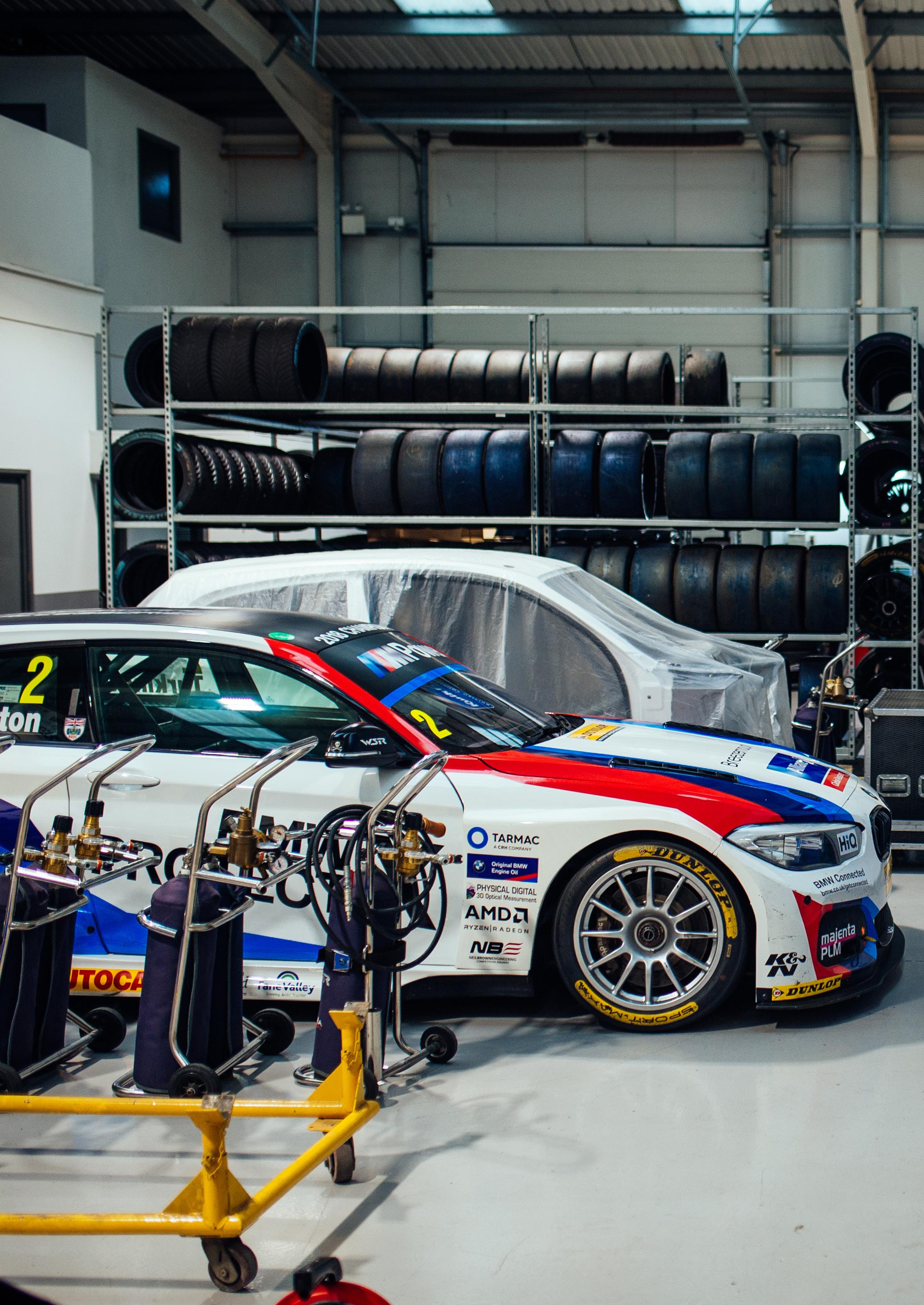
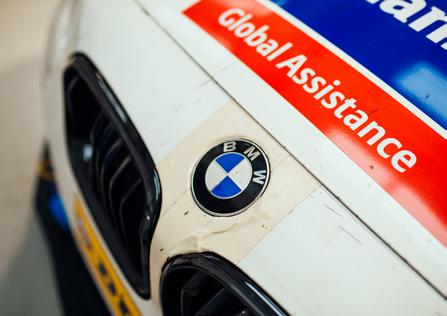
Success in Surrey
West Surrey Racing, the official BMW team in the British Touring Car Championship, are enjoying quite a winning streak. Having just claimed the 2020 Teams’ and Manufacturers’ BTCC crowns in a manic three-month season, Straight Six’s Andrew Coles stopped by for a rare tour.
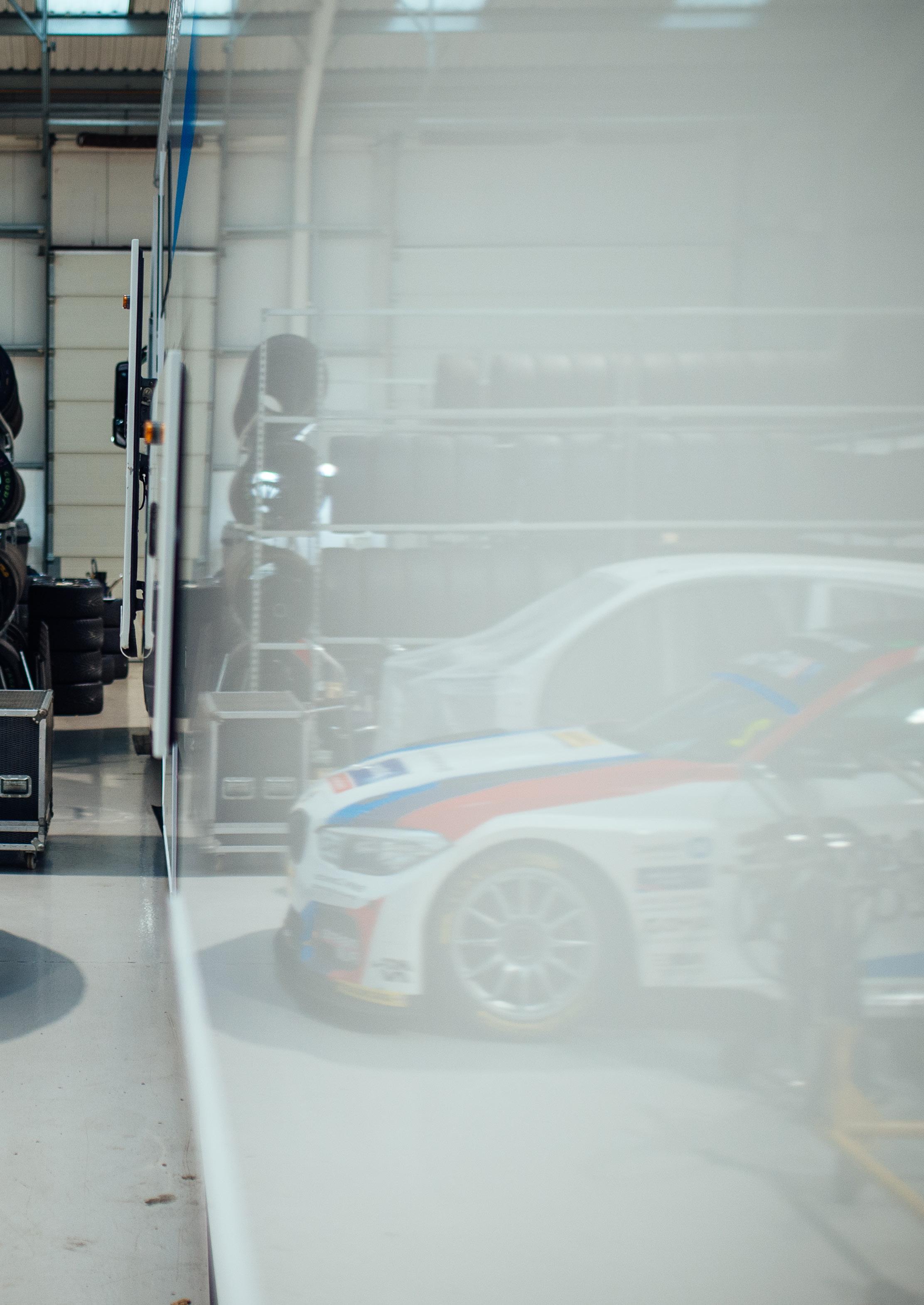
Iwonder how many delivery drivers have left parcels at West Surrey Racing while completely oblivious to the sheer magnitude of legendary fingerprints to have pressed that doorbell before them.
After all, you could be forgiven for missing it entirely. A grey-coloured warehouse in Surrey with a few BMWs parked out the front and ‘WSR’ above the door. It could be anything – a logistics company? A medical supplies business?
But as a fan of motorsport, the thought of who else had rung this doorbell echoed in my mind as I gingerly extended a hand. Ayrton Senna, Mika Hakkinen, Rubens Barrichello, Mauricio Gugelmin, Jonathan Palmer, Nigel Mansell and Tom Kristensen have all driven for the team and surely visited regularly.
The door is answered by Team Manager Carl Mitchell, who welcomes me into an impressive waiting room showcasing the team’s considerable success since its establishment as a Formula 3 team in 1981 by New Zealander Dick Bennetts. Clearly, this is no logistics company.
In its F3 days the team won five British championships, including its debut race and season, and the prestigious Macau Grand Prix twice. It switched to touring cars in 1996, running Ford’s works Mondeos in the heady Super Touring days of the late 1990s and early 2000s. As a kid in Australia I was addicted to TOCA Touring Cars on Playstation 1, and there was a twinge of nostalgia in seeing the actual trophies from the real races on WSR’s shelf. I, too, won the Silverstone round in the year 2000!
Over the years WSR have run manufacturer-backed BTCC campaigns for Honda and MG/Rover before a switch to BMW in 2007. The team secured official Manufacturer support in 2017, the brand’s first official presence in the BTCC for over two decades, a just reward for a remarkable run of success that has so far netted four outright Drivers’ championships, five Manufacturers’, four Teams’ and two Independents’’ with BMW in the BTCC.
My visit is timed well – less than a month earlier WSR claimed both the 2020

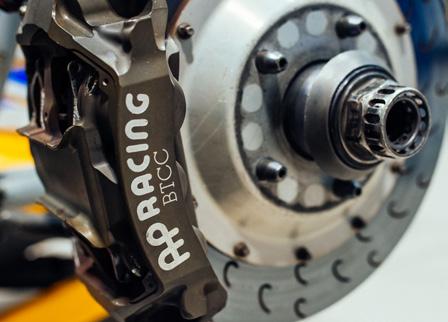

Manufacturers’ and Teams’ titles with the G20 330i M Sport. 2019 champion and BMW Car Club patron Colin Turkington narrowly missed out on a clean sweep of the championship, going into the Drivers’ title decider with a nine-point lead but narrowly finishing second to Ashley Sutton.
After gawking at the impressive collection of trophies spanning the past four decades and Jonathan Palmer’s early Ralt Formula 3 car sitting on display in the entrance hall, we step through a nondescript door and into the subassembly room. It is clinically clean, like a scientific laboratory, and a faint scent of gear oil permeates the air. There are fixed gearbox stands in the middle of the room, with benches running around the perimeter, all under bright LED lighting. The cars are stripped to almost a bare shell in between each race weekend, and the various subassemblies are brought into this clean environment for rebuild and inspection by the mechanics, under the supervision of chief mechanic Steve Buckell.
The gearbox is disassembled for inspection and then rebuilt with the ratios required for the next circuit, the clutch is inspected and re-shimmed, and the differential is rebuilt after every second weekend. The hubs are stripped down and careful attention is paid to bearings and seals, especially if they have been run in the wet. The dampers are tested on a SPA shock dynamometer to check that they have not lost fluid or pressure and are behaving as expected, and the entire front and rear subframes are stripped, cleaned, inspected and rebuilt. The BMW B48 engine itself is sealed, but it undergoes a thorough visual inspection on the bench after each weekend.
This is preventative maintenance taken to the extreme, but Carl says it has many other benefits aside from avoiding failure.
“There’s a bit of a limit where you don’t want to introduce issues by constantly changing things, so we try and stick to what we know. If we’re aware of a certain component only lasting three-quarters of a season we’ll change it, but we don’t do everything as a matter of course. But the benefit is that because the mechanics are so well drilled in taking the car apart, they can do it really quickly if they need to.
“The BMW and RML (manufacturer of

series control components) parts don’t usually give us any issues. Everything on the car is lifed, so as long as we’re within that life we know how far we can go. As long as the cars are regularly stripped for inspection and looked after we know they can keep going, they’re built to last.
“The B48 itself is actually a very well designed and built engine. Neil Brown Engineering, who look after the engines, do a great job of rebuilding them at the end of the season. We service them intensively, obviously we’re fairly limited by what TOCA has sealed and what isn’t possible from a legality point of view but the mechanics are very meticulous in checking everything they can – engine out and on the bench is normal between events”.
We continue on, and move into the main race shop. It’s an expansive open space with pristine floors and bright LED lighting. There are six bays, two of which house the famous 330i M Sport’s of Turkington and Oliphant, which are up on stands, partially disassembled with subframes off and engines on the bench. The final race of the season may have taken place, but the team are already preparing the cars for testing ahead of next year’s season. It’s a cycle that never ends.
The BMW branding on the cars and team uniforms is prominent and almost every car in the carpark (including an M8 Competition at the door) is a ’20 plated BMW, and Carl explains what it means to be an officially supported team.
“We’re not a full factory team, they don’t exist anymore, in the sense that nobody is entirely funded by a manufacturer these days. We still need to go out and find sponsors, and the drivers bring their budgets, funded by their own individual sponsors.
“However, we are certainly considered a manufacturer team for a reason – we do get plenty of support from BMW. We get parts and direct technical support, and BMW do us some favours too, things like keeping a full G20 3 Series bodyshell in their local parts stock. I think we’d be the only people in the UK to ever order a whole bodyshell…”
WSR are a manufacturer/constructor in that they design and build BTCC cars as well as run them. In 2021 WSR will supply two further G20s as customer cars, and during my visit these cars were under construction. The fourth workshop bay was full of an entire car’s worth of spare parts, delivered directly from BMW’s UK parts warehouse. There’s everything from headlight assemblies to bonnets and complex plastic brackets, but Carl says that almost every production part is modified by the team in some way, usually to either lighten or strengthen it. A new body shell sat in the fabrication shop, a few days away from paint.
A BTCC 330i M Sport starts life as a regular G20 shell, picked off the production line and shipped to the team. The front end is cut off at the a-pillar and discarded, and the shell is then sent to chassis fabrication specialist Willie Poole Motorsport in Warwickshire, who installs the WSR designed, FIA


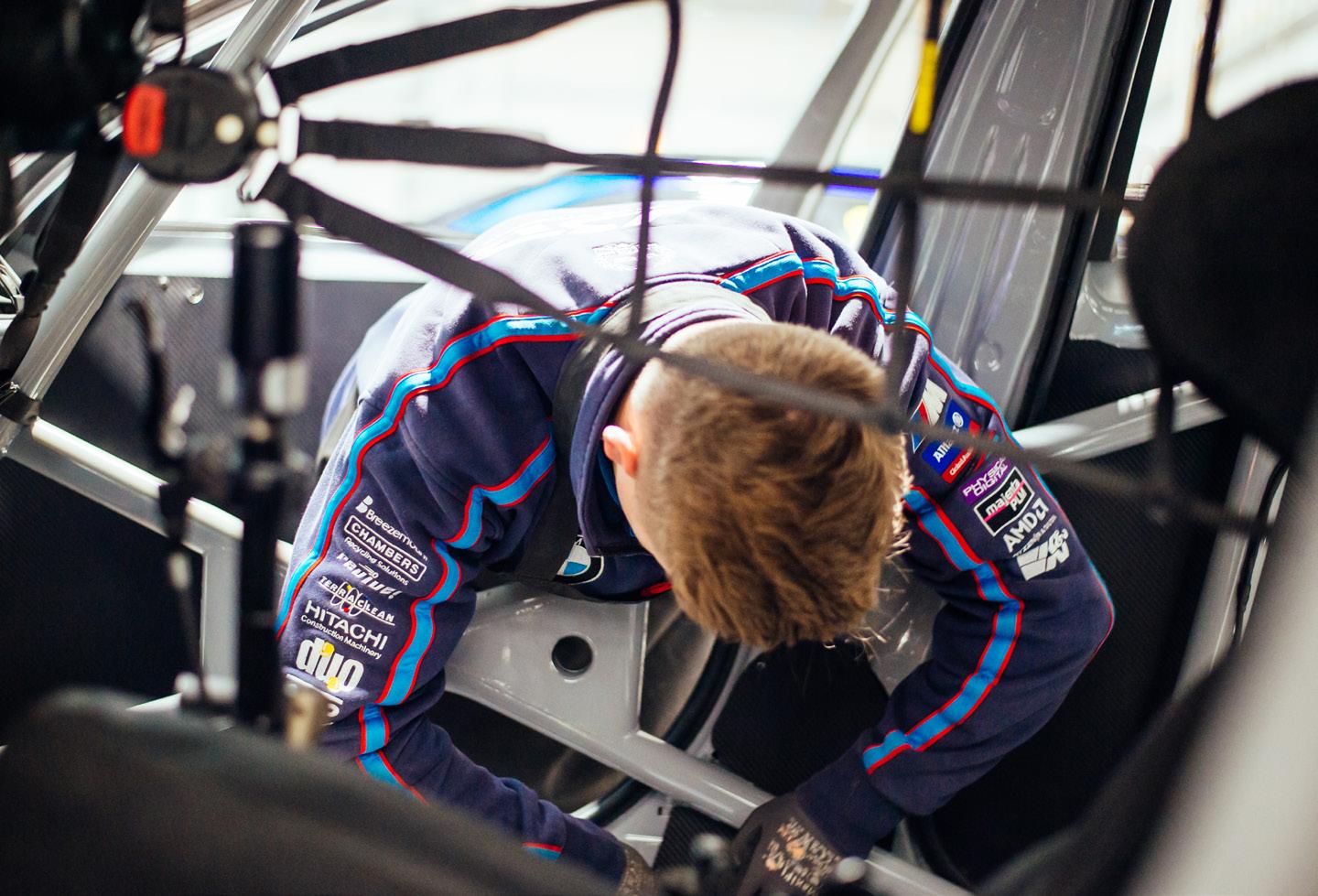
controlled roll cage and new front end according to WSR’s design in a process that takes about a month of full-time work per chassis. It is returned to WSR’s fabrication shop where a further week is spent on finishing and prep, and any unnecessary fixings and brackets are removed. It is then sent away for painting internally and externally.
In terms of panels, the original BMW aluminium bonnet and doors are retained, along with the plastic rear bumper cover, but parts of their structure are removed to reduce weight. The BTCC body kit itself is produced by Goodwood Composites from a special type of fibreglass (carbon is outlawed in the BTCC for all non-safety critical components) which is surprisingly easy and viable to repair. A damaged front bumper, for example, can be put back into its original mould with any missing bits simply layered up again.
From the point that the team gets the painted shell back to the workshop, it takes a further two months of fulltime Monday to Friday work (and some weekends, Carl quips), to build into a finished car ready for shakedown. A rolling chassis costs in the hundreds of thousands to build, not counting any labour, which is accounted for as a fixed overhead. As for the final value of the car, Carl says that it fluctuates according to the various global regulations at the time, and where else the car can race other than in the BTCC. WSR then facilitates a customer team to run the car themselves by providing support, technical advice and a supply of spare parts.
Parked in a spare space is Turkington’s 2018 championship winning 1 Series, in the exact condition it finished its last race (tape and all) and is destined for a private collection. Alongside it is a brand new 1






THEALL NEW BMWALPINAB3 TOURING. YOUNGER. GREATER. STRONGER



“The B3 Touring earns five stars because there is arguably no other car on sale that so successfully slathers its appeal across the realms of comfort, performance, practicality and engagement and –relative to other cars against which it competes – value for money. It is one sensationally rounded product. ” –Autocar 04/11/20
For further information contact Gary Lott,ALPINAGB Brand Manager, garylott@sytner.co.uk.
• 340 kW (462 hp) • 700 Nm • 0 - 100 km/h 3.9s

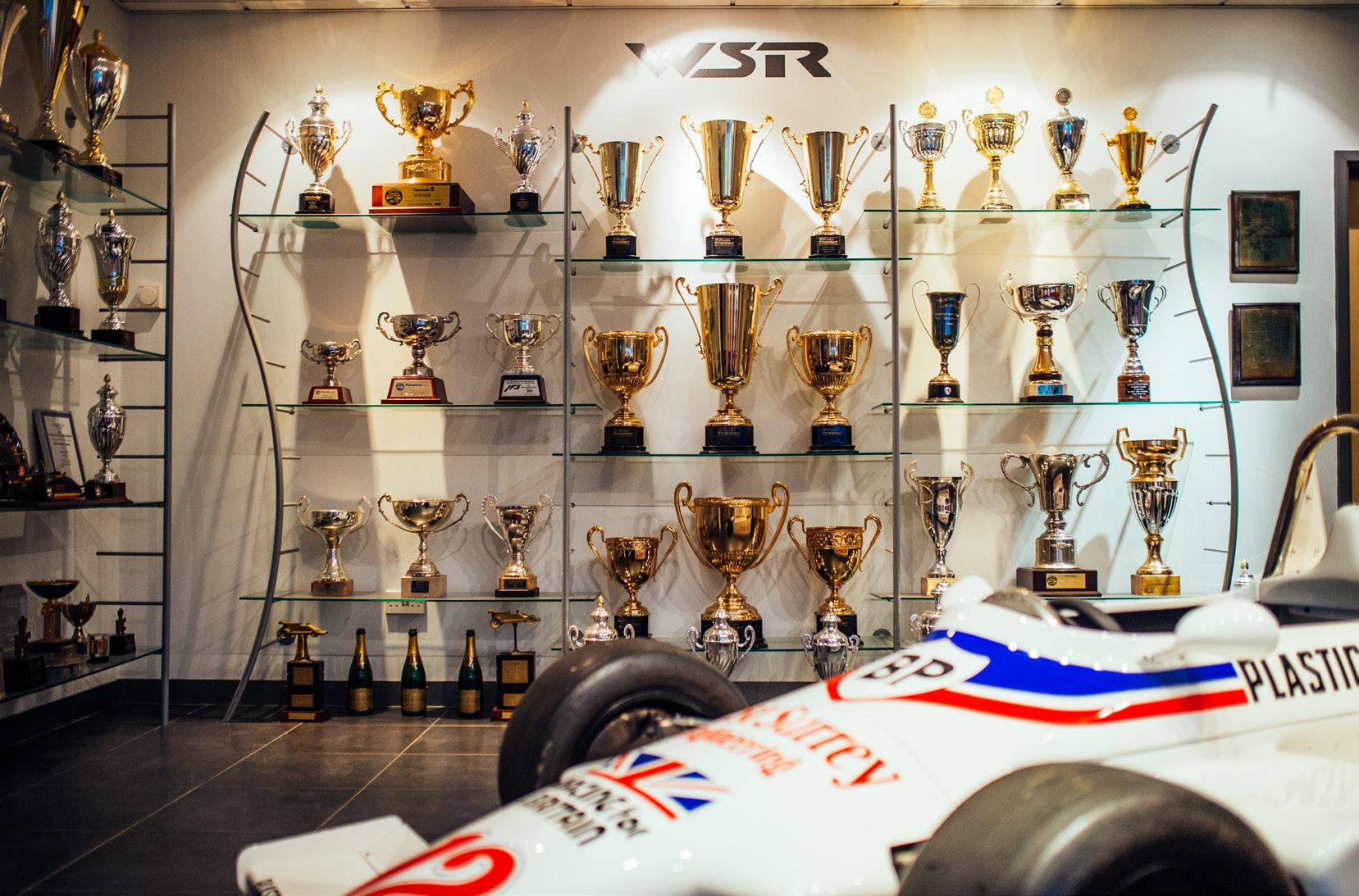
Series chassis, the fifth built by the team - it was kept as a spare when the team ran the 1 Series but was never needed.
One of the team’s two large articulated transporters dominates the race shop, and these are the team’s central nervous system come race weekend. Each transporter has an office at the front of the trailer and it is here that Carl lives onevent, alongside chief mechanic Steve. As Team Manager Carl’s focus at the track is primarily on compliance with the sporting regulations, and making sure that all rules are being observed.
“When we have to go and see the Clerk of Course it’s me that usually goes with one of the drivers and I’m flicking through the regulations to see if there’s a loophole or anything, but normally we just have to say sorry and accept that we shouldn’t have tapped someone!”
Behind the offices, work benches run the length of the trailer and the drawers contain every spare part imaginable. The cars are parked on top of the benches for transit, and flight cases containing major components like spare engines and gearboxes slide in between. The team takes these two articulated transporters and an 18-tonne rigid to each event.
“We take everything to a race weekend. Spares, even our damper dynamometer. We have the same equipment on site that we have in the workshop. If we have to, except for the shell itself, we can fully rebuild an entire car from what’s in these drawers and trust me, it wouldn’t be the first time we’ve had to do that!
“Even saying that, we’ve repaired shells at the track. Once at Croft there was a big qualifying accident and we could pretty much stand in the rear end of the 1 Series. One of our sponsors actually came to the workshop and picked up some bodyshell parts, and then Willie Poole met us at the track and welded them in, and we made the race.”
This anecdote from Carl is indicative of the most important part of the team – its people. As good as the facilities may be, as good as the car is and as highprofile as having manufacturer support may be, at the end of the day it comes down to individual effort. The entire operation relies on highly skilled people who are fully dedicated to the job.
“I wouldn’t say it takes over your life but it is a big commitment, it’s 10 weekends away per year plus testing. You have to really want to be there. Sometimes it’s late nights, long hours, you are away from home quite a bit but it’s what we all like to do. It’s not just a job for the sake of doing a job.”
After a bizarre 2020 season that saw a staggering nine race weekends condensed into a manic three and a half months, Carl and the WSR team are looking forward to consolidating their success with the 330i M Sport in what will hopefully be a more normal 2021 season.
And as for me, I step back out and into a cold, rainy Surrey day. I turn around and look at the nondescript building, grinning with the knowledge of what’s going on inside. I bet Senna did that, too.


The Perfect Balance?
Words: Bob Harper Photography: BMW UK
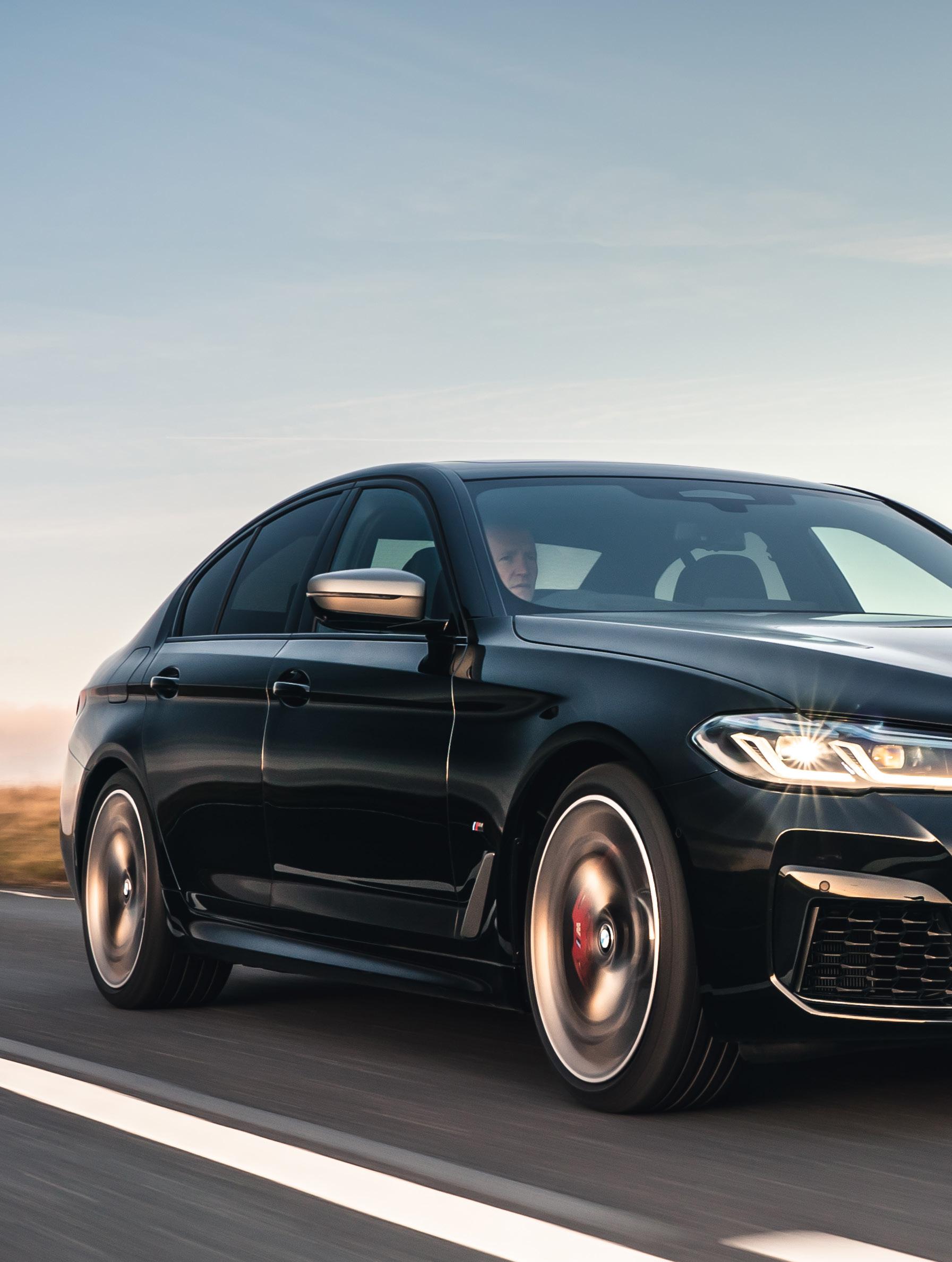
The M550i xDrive isn’t a full-fat M car but with 530hp it’s still a hugely fast and capable machine, and undercuts the M5 Competition by a not insignificant £30,000. But is it a viable alternative?
Amid the controversy surrounding the debut of the new 4 Series, with its new rather ungainly visage, and the even more divisive iX all-electric SUV, BMW’s 5 Series has gone through its mid-life refresh without too many changes to its appearance. It still looks svelte and stylish, no mean feat for a car that’s as big as a 7 Series used to be just a couple of generations back.
There’s been some fiddling with the model range too, with a new six-cylinder hybrid (the 545e) joining the fray while another six-pot, the 540i in saloon guise, has been quietly dropped from the line-up. Another casualty is the 530i, presumably as most 5 Series purchases are company cars and the hybrid 530e’s 10 per cent Benefit in Kind tax bracket makes it a no brainer on the financial side of the equation. This left what you could call a gaping hole in the petrol-engined saloon offerings, with nothing in between the 184hp 2.0-litre 520i and the 625hp M5 Competition.
That gap is obviously partially plugged by the 530e and 545e but if you don’t have access to home charging then BMW has thoughtfully come up with another option, the M550i xDrive. It’s unlikely to be a big seller but does offer an intriguing alternative to the ultimate supersaloon,

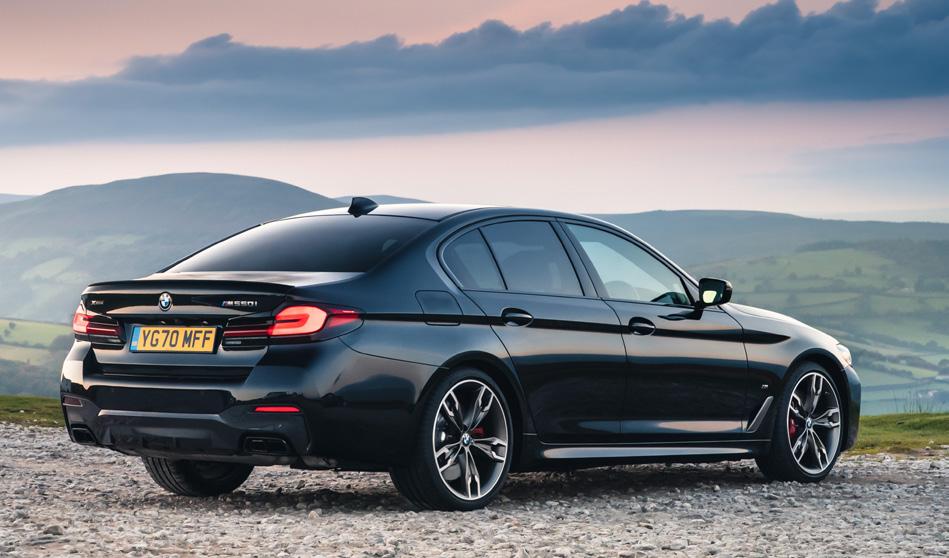

the M5 Competition.
On paper the M550i has a huge amount going for it. At £71,365 OTR it undercuts the £102,325 M5 Competition by a cool £30k and when you consider they both make use of a 4.4-litre twinturbo V8, both have all-wheel drive, both have sub-four second 0-62mph times and both are pretty loaded with all the kit you could ever want in your executive express; the M550i xDrive looks like a bit of a bargain.
Yes, the M5 Comp makes more power (625hp versus the M550i’s paltry 530hp) and yes, the M5 is quicker to 62mph recording a time of 3.3 seconds to the M550i’s 3.8 seconds. But let’s face it - you’re never actually going to need to travel faster than you can in an M550i. The cheaper car doesn’t really lose out when it comes to equipment either – it’s more or less on a par with the M5 – and the M550i does have an LSD, adaptive M suspension and big brakes so it should be able to cope with putting the power to the road and hauling it down from speed when required.
Obviously the M5 Competition does get the finely-honed M underpinnings but the M550i xDrive is an M Performance machine so it’s not just a bog-basic 5 Series with a huge engine. The cheaper car does lose out on a couple of pieces of standard kit that you get in the M5 – most
M550i xDrive


Engine: N63, turbocharged V8
Capacity: 4395cc
Max power: 530hp @ 5500-6000rpm
Max torque: 553lb ft (750Nm) @ 1800-4600rpm
0-62mph: 3.8 seconds
Top speed: 155mph (limited)
Economy: 25.4-25.9mpg
Emissions: 247-252g/km
Price (OTR): £71,365
notably Merino leather and a head-up display – but both can be added should you so desire.
On paper it would seem like there’s very little to choose between the two cars but are the differences on the road more marked? Having driven both cars back-to-back it’s fair to say that for the vast majority of the time the M550i xDrive makes a far better case for itself than the M5 Competition. In terms of raw speed the M5 does ultimately feel a smidgen quicker, but given you can only keep the throttle pinned for around three or four seconds before you’re heading into licence losing territory it’s a bit of a moot point unless you have a section of derestricted autobahn to hand. Suffice to say the M550i is plenty fast enough, piling on speed with the merest flex of the ankle. It sounds good, too, with a bassy V8 soundtrack that stacks up just fine in comparison to the M5, especially in Sport mode where it does add a rather decent snarl to its repertoire.
Where the M550i really scores over its full-fat M counterpart is with its slightly softer nature, especially in regard to its suspension settings. In every mode the M550i is more compliant and soaks up the worst our rutted highways can throw at it, giving passengers a far more cossetted experience than the M5 which can feel a little too hardcore at times, especially in its Sport mode. The flipside is that the M550i isn’t perhaps quite as keen to turn-in to corners, but at the same time it doesn’t feel riddled with understeer either. And there’s very little to choose between the two cars in terms of grip – both offer four-wheel drive with a rear-biased feel, although it’s only the M5 that can be turned into a rear-wheel drive loon at the press of a button.
As an all-rounder it’s safe to say the M550i xDrive is a better prospect than the M5. On the odd occasion when you can actually make use of the M5’s performance and poise it is a more enticing steer, but I wouldn’t be surprised if plenty of customers decide to buy the cheaper car and save £30,000 in the process. It’s as fast as you could possibly need, is well equipped and shouts a little less about its performance. In short, the M550i xDrive is the consummate all-rounder and a very worthy M5 rival.

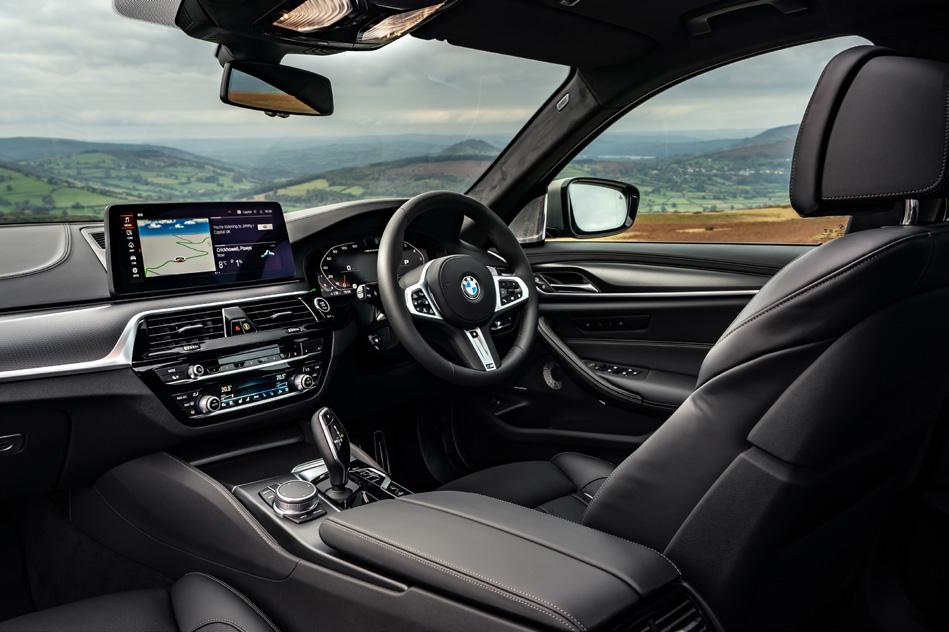
4 Series round up
If the prospect of spending £70,000 on a large saloon seems a little too much or if you simply don’t need the space and fancy a more rakish package, then the new 4 Series Coupe would definitely be worth a look. Yes, the front-end styling is divisive and rather colour and spec sensitive but in the flesh it’s better than expected.
At the media event where we drove the M550i and the M5 there was also a chance to sample the 4 Series in 420i, 420d and M440i xDrive guises. As well as the new styling there are some changes to the 4 Series range for this generation – the only trim level is M Sport and the only transmission option is the eight-speed ZF auto. If you’re after comfy SE spec suspension and the ability to change gears yourself you’re going to be disappointed.
First up on our driving list was the M440i complete with 374hp, a 4.5-second 0-62mph time and a hefty £53,875 price tag. In short it’s a great piece of kit – very rapid, comfortable and with a very grippy chassis thanks to its four-wheel drive. The steering is a let-down being pretty lacking in feel until the front wheels are really loaded up and it doesn’t feel very exciting to drive fast as it’s so incredibly planted.
No doubt the 420d will be a big seller – especially with company car drivers – and in the rear-wheel drive version it feels like a very well balanced machine. Quick enough – 0-62mph takes 7.1 seconds – yet also pretty economical with official figures suggesting up to 72mpg is possible.
However, it was the entry-level 420i that grabbed our attention and at £39,870 it’s the only 4 Series that can be had for less than £40,000. With only 184hp it isn’t hugely quick (especially when compared to the M440i) but it will rock along plenty fast enough and you feel like you have to work with the car to extract the best from it. Its handling is very tidy too, with great turn-in and taut body control and a chassis bias that feels more akin to what a proper rear-wheel drive BMW should feel like.
The spring of 2021 will see the 430d and M440d make their debuts (both with xDrive) and if a quick spin in the M340d Touring is anything to go by the M440d could well be the pick of the range. But for the time being the 420i represents the sweet spot of the 4 Series line up.
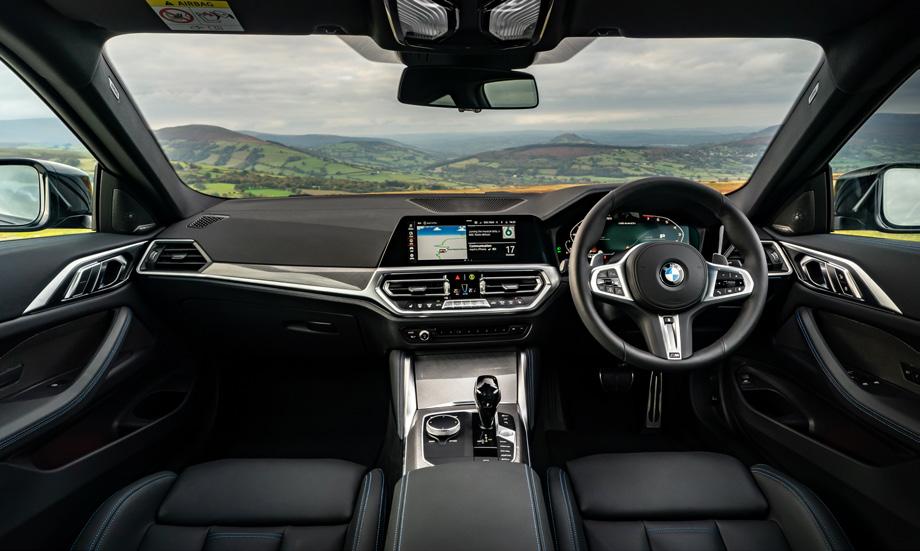

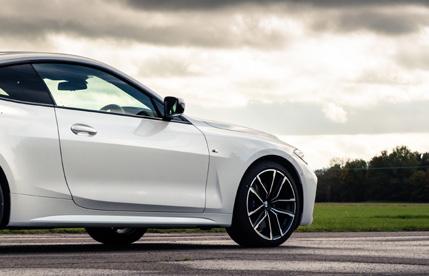
An emotional
new home… In 2012 my best friend finally opened his chequebook and spent the most he had ever spent on a car - and other than his house, the most he had ever spent on a single item. Words & photographs: John Denny

He purchased a 2001 BMW E46 M3 in Carbon Black with 76,000 miles on the clock and a good service history. Whilst I spent most of my time buying, selling and polishing my cars, Phil, my best friend, used to drive and enjoy maintaining his M3, and spent the time he had with the car performing all the servicing and maintenance himself using all the correct parts, tools and procedures.
Sadly in 2018, we lost Phil, and his car passed to his lovely wife Emma, another of my great friends. She was the proud custodian until the cost of running a 15-year-old M car was no longer practical, and she was going to move the car on to make way for a more reliable and cheaper to run solution. I stepped in to help her, and she now has a stunning 218i M Sport, and eight years after first seeing Phil’s M3, it now sits on my drive as my next project.
I bought the M3 without even looking at the car. I knew roughly what it was like, as it had been outside my house on and off most weeks for the last eight years whenever Phil visited, and of course I had been out in it as a passenger. It did occur to me, as Emma handed me the keys after I paid her for the car, that I had not sat in the old girl in over two years, and had not driven her since I first test drove the car for Phil when we inspected it back in 2012. It didn’t matter though, I was buying Phil’s M3, not just any M3. So I slipped into the driver’s seat, fired her up, and drove her the hour back to my house.
As I sit at home typing this tome, I consider that this must now be my twentieth M3, and I think I’m right in saying it’s my sixth E46 M3, and though I have had more E36s over my life, I’m fast realising that the E46 is my favourite model.
Even though she’s a manual the gearbox is still positive, owing to Phil replacing the selector bushes, and the exhaust note of the E46 M3 is just music to a petrolhead’s ear. I know some people are not a fan, but for me it’s the car’s signature, only improved when you add a CSL’s induction roar. The chassis is nice and tight, and although the car has now done close to 100,000 miles, most of the suspension bushes and ball joints have been replaced over the whole car as part of Phil’s servicing.
Back in 2012 when we first viewed the car Phil brought his ramps with him, and we actually gave the old girl a thorough inspection, as that’s how Phil was, very precise.
After doing all his homework on the E46 M3, as well as having seen all the issues I had encountered with the three I had owned by this time, he was as prepared for an inspection as anyone. What he was able to find evidence of were subframe cracks; this was quite embarrassing for me, as he pointed out the cracks to the seller. It was a little cringeworthy but after the shock had settled we were able to strike a deal for the car, knowing that Phil, being a cracking welder, would be able to sort it out in the future.
My first E46 had no issues with the floor that I was aware of, but it was a new thing back when I first had an E46
Phil on day of collection
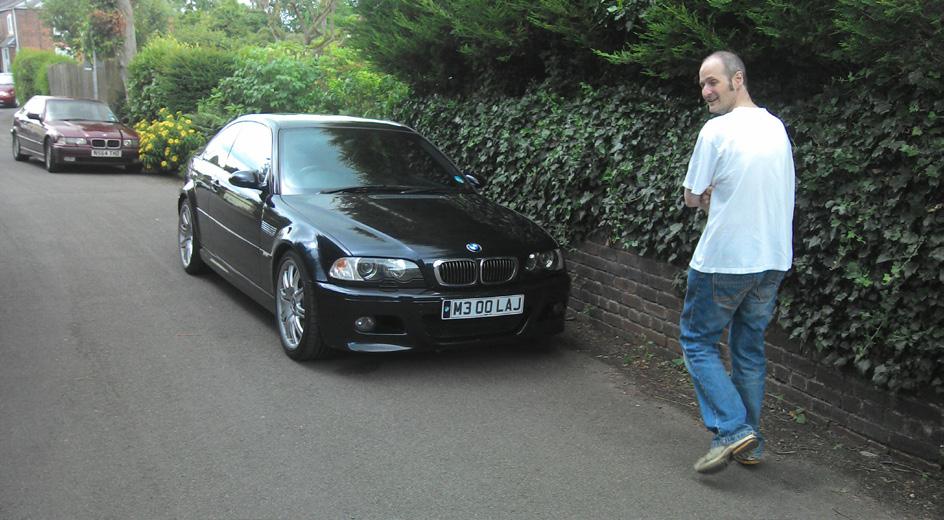
M3, and after I sold it the new owner wrote it off, so it wasn’t on the road for long. My second E46 was sold into the dealer network and it transpired that it had started to have issues, then the last three E46s prior this current car had all had complete floors fitted under warranty by BMW. So never has a “known” issue been so true with the E46, I guess it’s always a case of when not if.
Fast forward to 2020, and I have started to give the new car some love, consisting of 2 days of washing, hoovering, cleaning, claying, polishing, waxing and a ceramic top coat, as well as replacing some odds and sods of missing trim clips and screws, as well as returning the interior trim to a light silver, as opposed to the black someone had added to the car earlier in its life prior to 2012. Though classy, I think the black trim pieces with the black interior on a black car is just a bit too much.
I also spent a few hours organising all the receipts and history for the car; it was like going back in time as I recalled all the work that Phil had done on the car, and of course there were his hand written notes on the invoices, which seeing again was very emotional for me, but there was something comforting about it all too.
Subframe fix
The biggest job that Phil undertook on the car was to fix the cracked subframe, and not only did he fix the cracks, he also fitted the Redish Motorsport reinforcing plates. He did all the work himself, on his own, lying on his back with the car on axle stands, on his drive in Bolton! Whilst the diff and rear suspension was out he changed the diff oil seals and all the bushes with uprated Powerflex parts. He was my hero, there was nothing he couldn’t fix on a car, there was no problem he couldn’t overcome. What’s even better, he would help anyone with their car, wherever or whenever they needed help, and did it all for free! He was such a generous man.
Phil detailed most of the work he’d done on the car, and I came across some of the pictures he took over the years of the jobs he’d completed; the subframe fix made up a good chunk of the images I thought I’d share with everyone, broken down in the steps Phil carried out the work. 1) The first step was to clean up the area to see the extent of the damage. 2) The damage was accessed and holes were drilled to relieve the stress of the cracks. 3) The cracks were then welded, before offering up the reinforcing plates.
4) The Redish Motorsport plates were

then welded up the same.
5) The freshly welded plates were then seam-sealed and painted before refitting
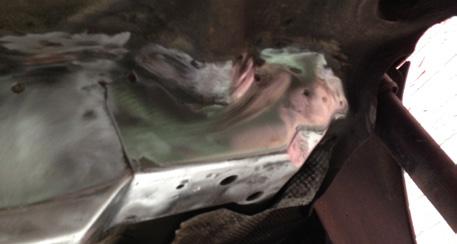




the axle.
At the time the car had done less than 80,000 miles, was 11-years-old and had full service history and no one had picked up on the cracks; fortunately Phil found them, otherwise he would have been out of pocket.
So in summary, I am back in an E46 M3 and loving it, and it’s special for an obvious reason. It’s not a special colour or a low numbers edition car, but it’s special to me because it belonged to my best mate, I just hope I can love it as much as I know he did for the time it was in his possession.
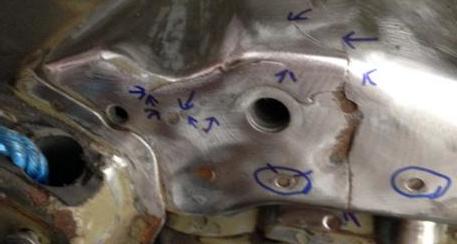

BMW B58 Oil
Filter Issue After a harrowing experience of an oil filter shearing inside a hard to reach housing, Club member Ian Bryant discovered a seemingly simple solution - an updated part number.

BMW’s B58 is a turbocharged 3.0-litre straight six engine that began production in 2015 and is part of BMW’s new modular engine family using 500cc per cylinder, following the B38 and B48 design. It replaces the N55 and is used in a wide range of current BMW models and the new Toyota Supra. It featured in the Wards Auto Top 10 best engines in 2016, 2017 and 2019.
I recently had the opportunity to change the oil on my son Sam’s M240i and having done routine maintenance on a wide range of BMW straight six engines, I was interested to see what’s different.
A quick look under the bonnet revealed that BMW have moved the oil filter from its usual friendly location at the top front of the engine to behind the engine, set half way down and at an angle. The design of the oil filter housing and cap is now plastic, with the filter itself being long and thin in shape. Initial impressions were not great, but it still looked simple enough with the right tools.

Old and new filter (Base has snapped off
I ordered oil and a Mahle filter from Opie Oils with the BMW Club discount; they arrived promptly and I commenced the oil change. Following a short drive to warm the oil, I put the car on ramps, drained the oil, replaced the sump plug washer and torqued to 25nm. The first issue comes with the car elevated at the front on ramps, to drain the oil it is really difficult to reach the oil filter housing to remove the filter. Once you get to the oil filter cap the removal was straightforward with a socket wrench, 6-inch extension and universal joint with 32mm socket.
The second issue with the oil filter removed, was that on closer inspection the base of the filter had sheared off inside the housing, which is really, really bad news. I cleaned the inside of the oil filter housing and could see the plastic base of the oil filter stuck in the housing, and being long and thin it’s really difficult to access and there is little room to pry this off.
I did what I always do when in a tight spot, ask Google, and to my surprise this is quite a common issue on the B58 engine. BMW Dealers have been replacing the housing on cars with this issue under warranty, and this is a labour intensive job due to the location of the oil filter. This issue is flagged as a Technical note on the BMW system, but there has been no recall. Some of the articles on the web are rather worrying in referencing dealers avoiding changing the filter. If you have concerns you can check the oil filter date, it is stamped on the top of the oil filter.
After further research it looked like the oil filter housing is not the issue, the removal is required purely to gain access to recover the oil filter base. The actual fix for the issue appears to be a revised design of the oil filter to strengthen the base, which makes sense.
With the cheapest quote coming in at £650 to replace the housing from a trusted BMW independent, I decided to follow an approach from an independent garage that seemed viable.
The solution involves melting a small pilot hold in the oil filter base; I used a fine tip soldering iron for this. The purpose of the hole is to allow a long screw to be driven into the base. There is reasonable clearance to get a couple turns on the screw and it went in really firmly. Then with trusty mole grips on the top of the screw, I could pull the offending item out and it worked well.
I then decided to purchase a new genuine BMW filter to compare with the old and the Mahle (which incidentally I have used for years with no issues in other models).
The part number -8584473-(01) - has not changed, but the revision has, to 8584473-(03). On closer inspection on the latest version (03) you can see the base is a stronger design, and the Mahle filter appeared a better design than BMW (01) but not as good as BMW version (03).
I fitted the new BMW filter, torqued to 25nm, filled with oil and the M240i is running nicely. The date on Sam’s oil filter was a couple of months before the last service in 2018, so we were happy it had

The oil filter base removed
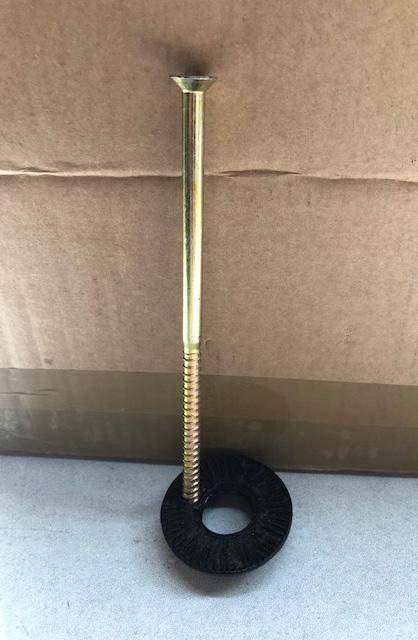
been changed previously. Fortunately the oil pan I used was spotless and we decided to strain the oil very carefully through some fine metal mesh to check for any foreign objects and nothing was found.
So hopefully this is the end of this particular saga, we will follow the advice of others who encountered this issue and change oil and filter annually, plus we will be using genuine BMW filter revision 03 from now.
I really hope you don’t encounter this issue, but if you do, this should help.
How about a transformation from The Empress….
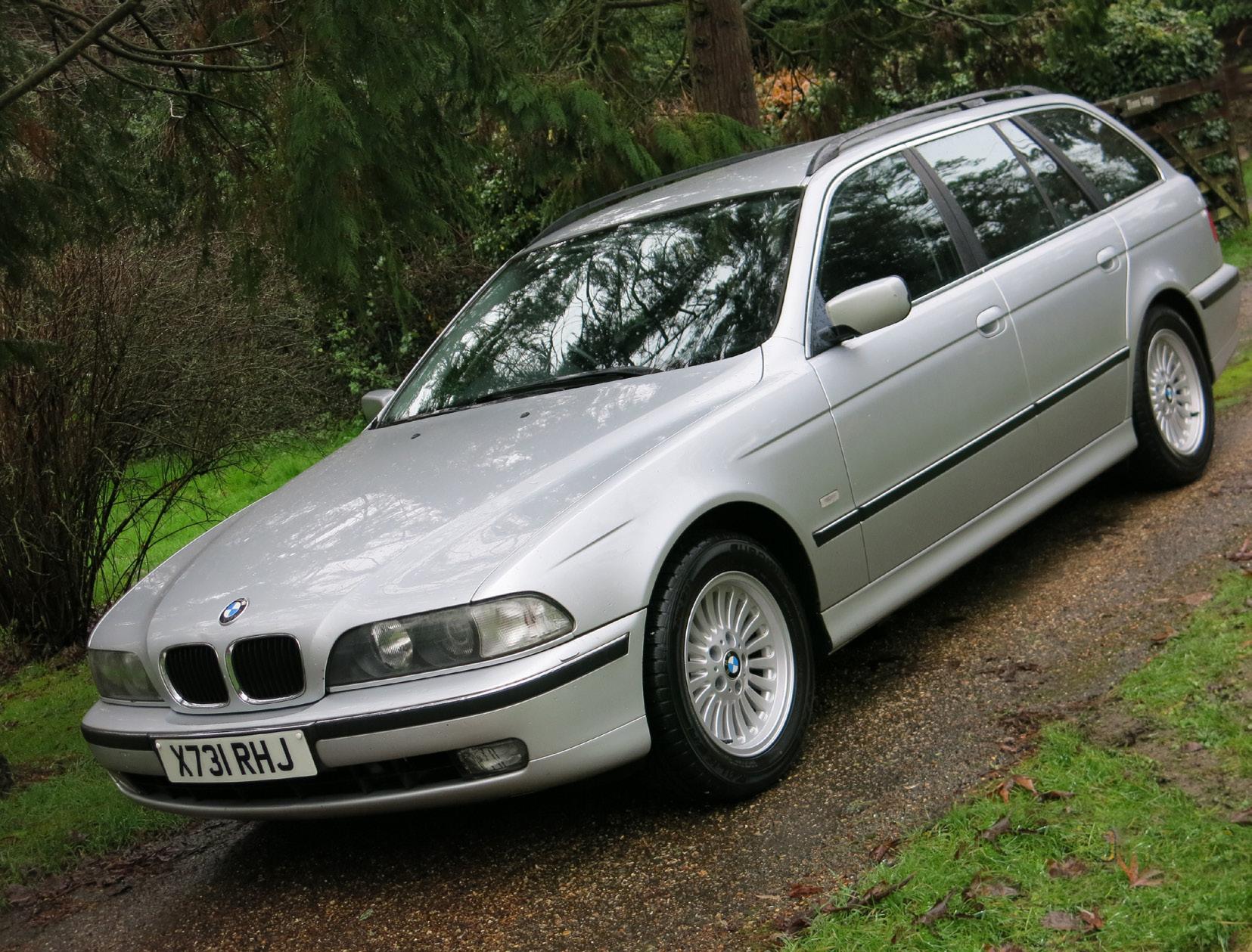
“The Empress” – Help!
Words by Richard Baxter Photographs by Richard Baxter & BMWBlog Back in 2001, while on the Club’s factory tour to Munich, I witnessed the E39 being built in the state-of-the-art factory made, the last of the ‘mechanical feeling’ 5 Series’. In general, it was seen as the pinnacle of the model and the Daily Telegraph even went onto proclaim it the at Dingolfing. To see the metal blanks best car ever made! enter the heavy presses, move on to the Even towards the end of its life in mesmerizing balletic welding robots – 2004 the E39 5 Series came out on placed so close to each other, that should top of all group tests, more comfortable the program fail they would literally smash than the Audi A6, better built than the into each other. Stage by stage these cars Mercedes E Class and more fun to drive came together in the factory process, each than either of them. step a fascination into the modern art of A humble E39 523i hire car provided car production. my first driving experience of the fabled
The cars were elegant in their design Nordschleiffe during the era of Sabine and a clever development up from driving the E39 M5 ‘Ring Taxi’. It was the preceding E34, (itself a fine and an experience never to be forgotten for underrated model) but with 40% greater those fortunate enough to be rewarded rigidity, improved crash protection and with awe and fear in equal measure, by intuitive controls (compare if you will to this ever-smiling, ever-delightful woman the following E60 with the ‘Mouse’ in who would thread the thrilling M5 through the center console! And lest we forget gaggles of motorcyclists, tourist coaches the first of the Bangle design of flame and every gung ho would-be ring jock, surface texturing), to produce what is flicking out the rear at will to straighten largely considered the best 5 Series ever the curve with four up…
Possibly, it was these long-shelved experiences that climbed out of the box upon sighting “The Empress” earlier this year, parked up forlornly in the corner of the MoT station that caused me to wander over and take in her condition: Straight panels, original paint, as standard as she had left the factory in 1999, one previous owner, clean throughout, new tyres, fresh MoT and 97k miles on the clock. What’s more, she ran quiet, BMW main dealer stamps in the book and all the switches worked. Even the air con was cold!
For no particular reason she was added to the fleet and in a few short months has become an almost indispensable addition, having since delivered an engine to Herefordshire, countless trips to the waste disposal sites and will consume bags and luggage at an alarming rate. As a people carrier passengers marvel at her comfort, civility and elegance and she will pull a car and
……to load bearing hot rod
trailer with stability and impunity that you question how could you ever live without this competent old lady, especially for the miserly £650.00 she cost!
Within days of her arrival I had received three offers to sell, (such is the general respect) but why would one, she has to be the best value car I have ever owned and the sweet six cylinder 2.5L engine with 170bhp is a peach and uses no oil.
Help!
But here is the rub; when does enough become never enough? Well, it is now! Because the reoccurring thought is to find a crashed, rusted out E39 M5 that can be the donor vehicle to give the empress the ability to pick up her skirt and fly with the fitment of the glorious S62 engine and a set of Xenon lamps to see in the dark.
Such a one-off car was carefully devised in the USA and to give the empress more than double the power would make this quite an exceptional and very practical car indeed, so the quest is on to find a donor and so far, this has proven to be difficult. The condition of the mechanicals is of no consequence because they would be totally refurbished.
Please, if anyone should know of such an available donor car this would make for a great project to transform the old girl into something more than the sum of her parts….

From one pipe……

...to M Power four

Expert Repair & Restoration of All Vehicles We Aim For Perfection Every Time Body Motorworks have over 23 years experience, 14 years of which were spent in a BMW Approved Bodyshop.




During the time in the BMW Approved Bodyshop, all available training was taken including: • Paint Expert • Paint Technician • BMW ATA

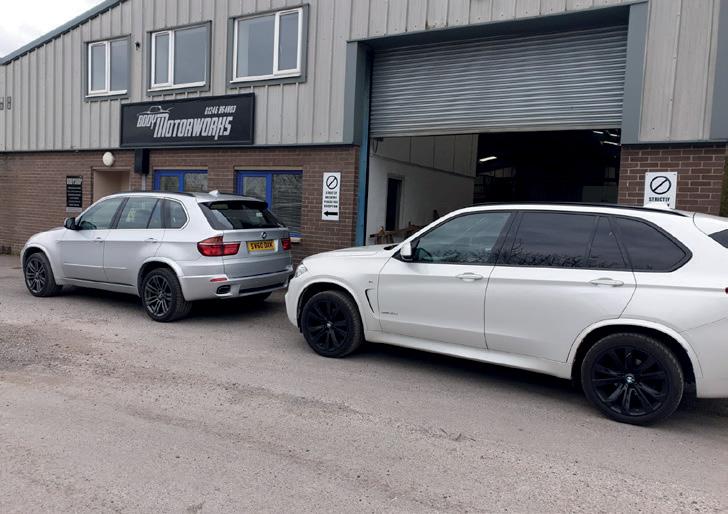
With that in mind, we feel we are in a strong position to deliver the high service that you require. Whether that be a simple SMART repair to remove the scuff on the front bumper or a full restoration project, removing all components, we aim to give 100% to ensure the highest quality workmanship can be achieved. With our unit based in Chesterfield, we have full facilities to conduct a high-quality, professional job including that of a spray bake to enable paint to cure as quickly as possible. This means that the high-quality work you have just paid for, is guaranteed.

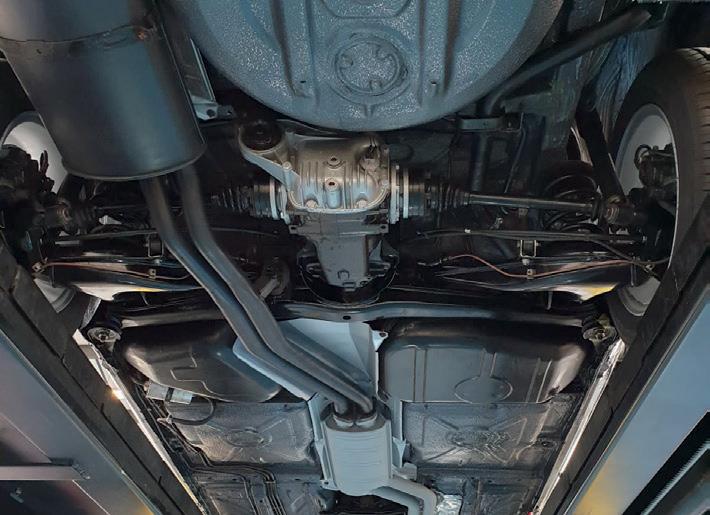


Request more information or book one of our services by calling 01246 864803











